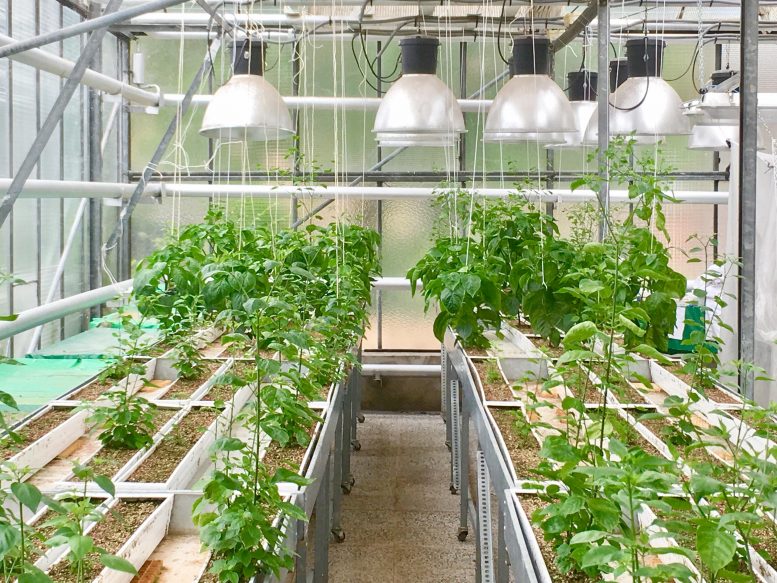
Pepper plants were grown in a greenhouse at the Museo Nacional de Ciencias Naturales (CSIC) in Madrid to investigate how their below-ground behavior differed when planted alone vs. alongside a neighbor. Credit: Ciro Cabal, Princeton University
You might have observed plants competing for sunlight — the way they stretch upwards and outwards to block each other’s access to the sun’s rays — but out of sight, another type of competition is happening underground. In the same way that you might change the way you forage for free snacks in the break room when your colleagues are present, plants change their use of underground resources when they’re planted alongside other plants.
In a paper published today in Science, an international team of researchers led by Princeton graduate student Ciro Cabal sheds light on the underground life of plants. Their research used a combination of modeling and a greenhouse experiment to discover whether plants invest differently in root structures when planted alone versus when planted alongside a neighbor.
“This study was a lot of fun because it combined several different kinds of mind candy to reconcile seemingly contradictory results in the literature: a clever experiment, a new method for observing root systems in intact soils and simple mathematical theory,” said Stephen Pacala, the Frederick D. Petrie Professor in Ecology and Evolutionary Biology (EEB) and the senior author on the paper.
“While the aboveground parts of plants have been extensively studied, including how much carbon they can store, we know much less about how belowground parts — that is, roots — store carbon,” said Cabal, a Ph.D. student in Pacala’s lab. “As about a third of the world’s vegetation biomass, hence carbon, is belowground, our model provides a valuable tool to predict root proliferation in global earth-system models.”
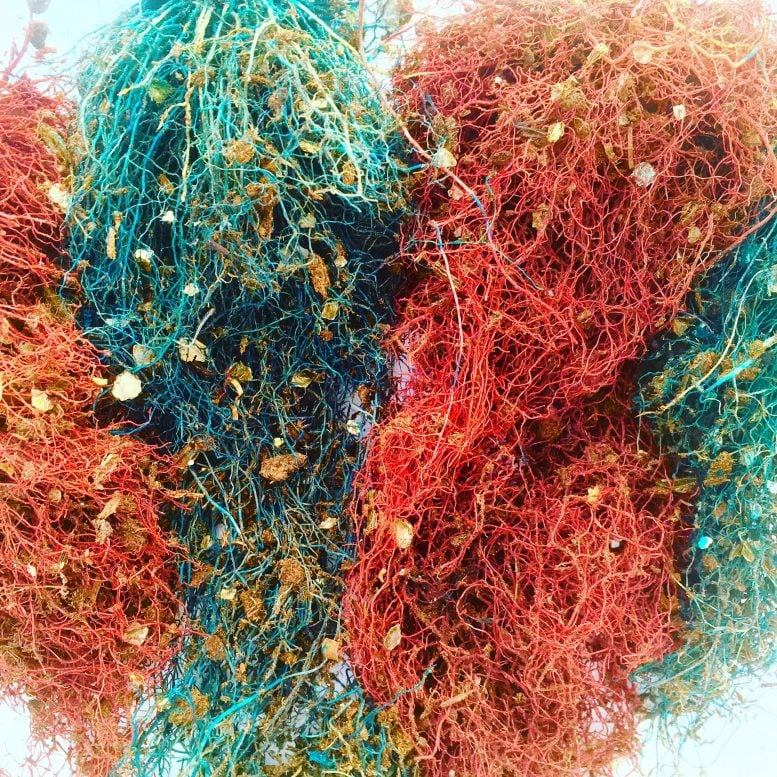
How do plant roots store carbon? Princeton researchers found that the energy a plant devotes to its roots depends on proximity to other plants: when close together, plants heavily invest in their root systems to compete for finite underground resources; if far apart, they invest less. As about a third of the world’s vegetation biomass (and carbon) is belowground, this model provides a valuable tool to predict root proliferation in global earth-system models. The pepper plants were grown in a greenhouse at the Museo Nacional de Ciencias Naturales (CSIC) in Madrid to investigate how their belowground behavior differed when planted alone or alongside a neighbor. The roots of neighboring pepper plants were stained different colors (by injection) to distinguish which roots belonged to which plant. Credit: Ciro Cabal, Princeton University
Plants make two different types of roots: fine roots that absorb water and nutrients from the soil, and coarse transportation roots that transport these substances back to the plant’s center. Plant “investment” in roots involves both the total volume of roots produced and the way in which these roots are distributed throughout the soil. A plant could concentrate all of its roots directly beneath its shoots, or it could spread its roots out horizontally to forage in the adjacent soil — which risks competition with the roots of neighboring plants.
The team’s model predicted two potential outcomes for root investment when plants find themselves sharing soil. In the first outcome, the neighboring plants “cooperate” by segregating their root systems to reduce overlap, which leads to producing less roots overall than they would if they were solitary. In the second outcome, when a plant senses reduced resources on one side due to the presence of a neighbor, it shortens its root system on that side but invests more in roots directly below its stem.
Natural selection predicts this second scenario, because each plant acts to increase its own fitness, regardless of how those actions impact other individuals. If plants are very close together, this increased investment in root volume, despite segregation of those roots, could result in a tragedy of the commons, whereby the resources (in this case, soil moisture and nutrients) are depleted.
To test the model’s predictions, the researchers grew pepper plants in a greenhouse both individually and in pairs. At the end of the experiment, they dyed the roots of the plants different colors so that they could easily see which roots belonged to which plant. Then, they calculated the total biomass of each plant’s root system and the ratio of roots to shoots, to see whether plants changed how much energy and carbon they deposited into belowground and aboveground structures when planted alongside neighbors, and counted the number of seeds produced by each plant as a measure of relative fitness.
The team discovered that the outcome depends on how close a pair of plants are to each other. If planted very close together, plants will be more likely to heavily invest in their root systems to try to outcompete each other for finite underground resources; if they are planted further apart, they will likely invest less in their root systems than a solitary plant would.
Specifically, they found that when planted near others, pepper plants increased investment in roots locally and reduced how far they stretched their roots horizontally, to reduce overlap with neighbors. There was no evidence for a “tragedy of the commons” scenario, since there was no difference in the total root biomass or relative investment in roots compared to aboveground structures (including the number of seeds produced per plant) for solitary versus co-habiting plants.
Plants remove carbon dioxide from the atmosphere and deposit it in their structures — and a third of this vegetative carbon is stored in roots. Understanding how carbon deposition changes in different scenarios could help us more accurately predict carbon uptake, which in turn could help design strategies to mitigate climate change. This research could also help optimize food production, because in order to maximize crop yield, it’s helpful to understand how to optimally use belowground (and aboveground) resources.
Reference: “The exploitative segregation of plant roots” by Ciro Cabal, Ricardo Martínez-García, Aurora de Castro, Fernando Valladares and Stephen W. Pacala, 4 December 2020, Science.
DOI: 10.1126/science.aba9877
The other co-authors on the paper are Ricardo Martínez-García, a former postdoctoral fellow in EEB who is now a professor at the South American Institute for Fundamental Research; Aurora de Castro, who worked on the project as part of an undergraduate thesis for the Department of Biogeography and Global Change at the Spanish National Museum of Natural Sciences; and Fernando Valladares, an associate professor in the Department of Biology, Geology, Physics and Inorganic Chemistry at Rey Juan Carlos University and a researcher in the Department of Biogeography and Global Change at the Spanish National Museum of Natural Sciences.
“The exploitative segregation of plant roots,” by Ciro Cabal, Ricardo Martínez-García, Aurora de Castro, Fernando Valladares and Stephen W. Pacala, appears in the December 4 issue of Science (DOI: 10.1126/science.aba9877). This work was supported by the Princeton University May Fellowship in the Department of Ecology and Evolutionary Biology; the Gordon and Betty Moore Foundation (grant GBMF2550.06); Instituto Serrapilheira (grant Serra-1911-31200); the São Paulo Research Foundation (grant ICTP-SAIFR 2016/01343-7); the Programa Jovens Pesquisadores em Centros Emergentes (2019/24433-0); the Simons Foundation; the Spanish Ministry for Science, Innovation and Universities (COMEDIAS grant CGL2017-83170-R); and the Princeton Environmental Institute Carbon Mitigation Initiative.

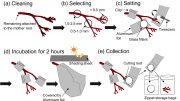
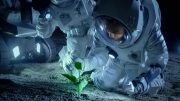
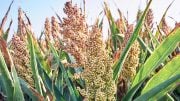
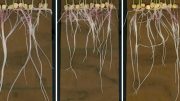

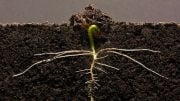

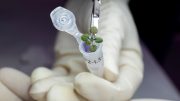
Extremely Interesting.
Princeton is one of the Best Univesity’s in the world and competes with other Ivy League Universities for wonderful state of the art research. Aways follow interesting research findings from this and other Univesrities from across the Globe — thanks to Digital Technology.
Here are some additional areas to conduct research in going forward.
1. Many Foods we eat grow Underground. Potatoes, Sweet Potatoes etc. Many Such Underground foods have a External Plant above ground — to gather the energy needed to carry out Photosynthesis. The Irish Famine drove many to US Shores …. Hope all IRISH Eyes I remember are Still Smiling. Maybe the Leprachaun with the Pot of Gold is hidden at the end of the Rainbow , however , if do not restore the Natural Water Cycle disrupted by Humans, as a result of cutting, trees, and clearing forests and destroying the same indiscriminately, and destabilizing the natural ecosystems, in which they survive , and burning forests , and Crop Stubble ( Punjab, Farm Stir Caused by Politicians to infalme the farmers without a science education and deep understanding of environment friendly farming practises) ,the Planet we inhabit is going to face a Disaster in the Short and Long Term.
2. The Long-Term absorbers of Carbo-Di-Oxide are getting destroyed by the Killing of the Forest Ecosystem across the Globe.
3.The Short-Term impact of burning crop stubble tomake the soil fertie for second crop makes air unbreathable. (AQI = Astronomical in Such Nations, Including India, China and many others!!) . Facetious: Maybe the adapbtable Human Ecosystem can adapt to breathe polluted air with high AQI by growing gills like the fish which breathes underwater!
4. Short-term Solution for reducing Carbon. Kudzu. Grows Fast . However not sure that it will absorb sufficient Carbon Di Oxide fast enough — to reduce Carbon in the atmosphere. Explore Other plants which grow lots of Roots and also Grow Extremely Fast.
6. Second Short Term/ Medium Solution for reducing Carbon. Redwood Trees. They Grow very tall and Photosynthesis is enabled .Large Storage Reservoirs of Carbon above Ground in the Trunks. Roots seem to talk to each other and work as co-operatively as ONE BIG Family and Look after Each Other and share information and Resources required.
7. Restore the Forest Ecosystem to Preserve Existing Carbon Sinks and and Reduce Carbon-release technologies by incentivising/penalising both sides the ledger. Change the behaviours for all Global Commercial Activities while encouraging GLOBAL Trade in Low Carbon Release Technologies and Products & Services ( Incentivize). Also, by Discouraging GLOBAL TRADE IN ALL High Carbon Technology Release Products and Services ( Penalize) by increasing he Global incentive to digitize ALL Services and Industries including the Worlds largest Industry – Tourism —- by incentivizing Eco Friendlly -Tourism, & ECO – Friendly- Travel and RE-Build those Industry’s rather than continue existing Industries with very large Carbon Footprints.
8. What the Virus Showed us that the World is less polluted and AQI is much lower when The Virus is afoot and People stay at Home. Economic Activity which is essential for Progress cannot stop. At the same time Economics of a Fossil-Fueled-Economy needs to be slowly and over a reasonable period of time, be replaced by non-fossil fuel based economy. The Price of blind faith in the Global Ecosystem fixing itself appears to be failing —-and Mother Natures Fury is being unleashed. This is my personal Opinion. ALL Suggestions and Opinions expressed are Personal and Not Binding on anyone. GOD Does not intefere in the Free Will Granted to Humanity. Choices iis to be made by Individual Humans, Communities, Socities, Nations and the World.
Spellings Corrected and some more thoughts and suggestions.
Extremely Interesting.
Princeton is one of the Best Univesity’s in the world and competes with other Ivy League Universities for wonderful state of the art research. Always follow interesting research findings from this and other Univesrities from across the Globe — thanks to Digital Technology.
Here are some additional areas to conduct research in going forward. Some additional thoughts included.
1. Many Foods we eat grow Underground. Potatoes, Sweet Potatoes etc. Many Such Underground foods have a External Plant above ground — to gather the energy needed to carry out Photosynthesis. The Irish Famine drove many to US Shores …. Hope all IRISH Eyes I remember are Still Smiling. Maybe the Leprachaun with the Pot of Gold is hidden at the end of the Rainbow , however , if we do not restore the Natural Water Cycle disrupted by Humans, as a result of cutting, trees, and clearing forests and destroying the same indiscriminately, and destabilizing the natural ecosystems, in which “they and we all survive” , and dont stop burning forests , and Crop Stubble ( Punjab, Farm Stir Caused by Politicians to infalme the farmers without a science education and deep understanding of environment friendly farming practises) ,the Planet we inhabit is going to face a Disaster in the Short and Long Term. Opinions expressed are Personal.
2. The Long-Term absorbers of Carbon-Di-Oxide are getting destroyed by the Killing and wanton destruction of the Forest Ecosystems across the Globe.
3.The Short-Term impact of burning crop stubble to make the soil fertie for next seasonal crop, makes air unbreathable. (AQI = Astronomical in Such Nations, Including India, China and many others!!) .
Facetious Aside: Maybe the adapbtable Human Ecosystem can adapt to breathe polluted air with high AQI by growing gills like the fish which breathes underwater!Seriously doubt it.
4. Short-term Solution for reducing Carbon. Kudzu. Grows Fast . However not sure that it will absorb sufficient Carbon Di Oxide fast enough — to reduce Carbon in the atmosphere. Explore Other plants, shrubs, trees and other growth , which need not look pretty but help us ensure that the environmental ecosytem in which we exist and thrive grow lots of Roots and also Grow Extremely Fast. Also use the help of other creatures other than humans to help maintain , restore and reapir the environmental ecosystem.
Examples include the Beaver, Armadillo, many other including Bees.
( Facetious Aside: “To Be Or Not to Be , is no longer the Question William. Your Spelling as as attrocious as mine. The Question is ; ‘To BEE or not to BEE!’. The Drone BEEs serve the Mother Queen BEE who probably tells them , ” No Work , No Honey Dears”. ‘. By the way not all Indians are as good at Spelling-Bee Competitions as people tend to think and generalise. Generalization and drawing conclusions without sufficient data and logic may very often lead to incorrect and wrong conclusions and lead the researcher up the garden path. HOWEVER INTUTION IS extremely important sixth sense and needs to be nurtured and developed.Too often , the development of Intuition is accompanied with loss of Humility and a complex of ” My way or the Highway attitude. Ego has no role expcept deletrerious one to play. Humility and respect for the views of others, however strange it may seem is a essential characterstics all humanity needs to develop in addition to respect for the sacredness of all life.
Coming back to a serious suggestions , the “Drone” Bee brings a extremely interesting new technology by the Aussies. Using Drones for Seeding the wild with Seeds to grow more trees. Doing so on a Global basis and enabling the same, by ensuring that the local ecosystems and soil condiitions, salinity, humidity, availability of water , ovygen and other essential nutrients are monitored and supplied using technology to maximise the efficiency of such technologies cost -effectively may be required to ensure mass afforestation.
6. Second Short Term/ Medium Solution for reducing Carbon. Redwood Trees. They Grow very tall and Photosynthesis is enabled .Large Storage Reservoirs of Carbon above Ground in the Trunks. Roots seem to talk to each other and work as co-operatively as ONE BIG Family and Look after Each Other and share information and Resources required.
Both Sunlight ( Photosynthesis) and essential nutrients are required for heathy plant growth. Whether the same are obtained from soil or are grown in hostile environments like saline water, dry soil, desert conditions, or even without soil (Hydroponics), Food and its production and availability to ensure survival of Humans andd other creatures of God is a choice facing humanity. By the way dont think that other creatures cannot change their food habits. I remember feeding a Dog pieces of the apple I was eating (when in USA) and sawhis tail wagging as he enjoyed the trat. Not just apple Pie , Moms , even fresh apples are delicious!
7. Restore the Forest Ecosystem to Preserve Existing Carbon Sinks and and Reduce Carbon-release technologies by incentivising/penalising both sides the ledger. This includes the 70 percent of the World which is underwater (Saline variety). In seven decades we have created mass extinction conditions underwater and not just on land.
Change the behaviours for all Global Commercial Activities while encouraging GLOBAL Trade ( TRADE IS GOOD) — in Low Carbon Release Technologies and Products & Services (Incentivize). Also, by Discouraging GLOBAL TRADE IN ALL High Carbon Technology Release Products and Services (Penalize) —-by increasing he Global incentive to digitize ALL Services and Industries including the Worlds largest Industry – Tourism —- by incentivizing Eco Friendlly -Tourism, & ECO – Friendly- Travel and RE-Build those Industry’s rather than continue existing Industries with very large Carbon Footprints. In the ancient world there were interesting tales of The Seven or Eight Wonders of the world. Well ,in he Modern Wold, There are Seven to Eight Huundred such Wonders of the World! If every Human Being usedcurrent day Fuel based Economy to travel the Globe and take in these wonders, we may not have much of a planet left!
8. What the Virus Showed us was that , when the World is less polluted and AQI is much lower
(and this is possible when The Virus is afoot and People stay at Home).
However, Economic Activity which is essential for Progress cannot stop. At the same time ,Economics of a Fossil-Fueled-Economy needs to be slowly and over a reasonable period of time, be replaced by non-fossil fuel based economy. The Price of blind faith in the Global Ecosystem fixing itself appears to be failing —-and Mother Natures Fury is being unleashed.
This is my personal Opinion, feinforced by the great deluge in Mumbai in July 2005. ALL Suggestions and Opinions expressed are Personal and Not Binding on anyone. GOD Does not intefere in the Free Will Granted to Humanity That means All Humans). Choices are to be made by Individual Humans, Communities, Socities, Nations and the World. Every one of us does have the ability toChange the world for the better, either silently or by tom-tomming about it from the rooftops, in our own small ways in whatever activities we undertake.